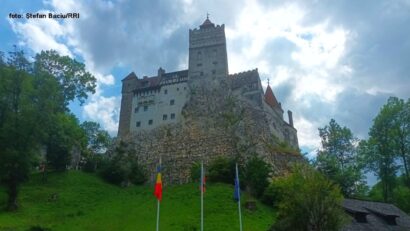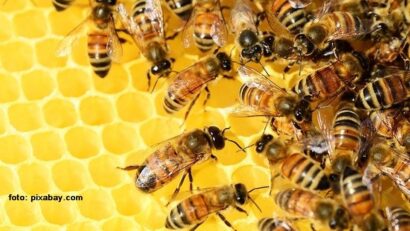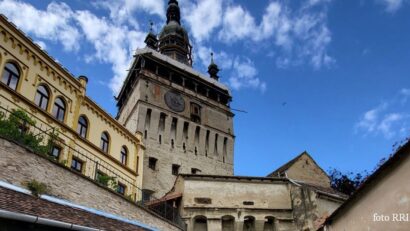Piatra Craiului National Park
Piatra Craiului National Park is one of the most spectacular mountain destinations in Romania

Daniel Onea, 11.09.2025, 13:00
Piatra Craiului National Park is one of the most spectacular mountain destinations in Romania. It is famous for its unique limestone peaks and rich biodiversity. You will also find here numerous marked tourist routes for hiking and cycling, adapted to various levels of difficulty. From an administrative point of view, Piatra Craiului National Park extends over the territory of two counties: Brașov and Argeș. The first step towards protecting this area was taken in 1938. In 2025, it is one of the most beautiful national parks in Romania, stretching over almost 15 thousand hectares. We also have many tourist routes here, as we learned from Mircea Vergheleț, the director of the administration. “There are 43 marked and approved tourist trails in the Piatra Craiului National Park. There are trails both in the low area of the massif, and trails that reach the ridge area, in the area of the rocks. There are also trails for cycling. We have designated 11 cycling trails. They can be found on the park’s website, even with GPX files that can be imported into GPS devices and followed by those who want to do this sport. They total a total length of approximately 120 km.”
Visiting virgin forests, excursions dedicated to observing brown bears from closed observatories, mountaineering and climbing, visiting Romanian sheepfolds, equestrian tourism, here are some landmarks from the offer that you will find on site. Added to these is the rich flora. Piatra Craiului National Park is home to approximately 1,200 plant species, which is a third of the total number of plant species in Romania. Ecotourism enthusiasts want to see, for example, the over 30 species of orchids in Piatra Craiului. Don’t think of exotic species. They look exactly like those, but they are very small. They are mountain orchids.
“Piatra Craiului, from this point of view, is a very important area, where the flora has been studied in particular. We have three main vegetation levels. The mountain level includes areas at the base of the massif, where we have special habitats. These are meadows that, through the care of the inhabitants, the landowners, retain their traditional character. One part is mowed, the other part is used for grazing animals. In this area, we have a very large number of orchids. Then, follow the forests, starting with mixtures of beech, fir and spruce, which are the most stable forest habitats in the mountain area, followed by altitudinal limit spruces. After that, we have the subalpine area, which contains shrubs, junipers, various other species, and, at altitudes over 2,000 meters, there is the alpine area, mostly with alpine meadows. I would like to mention that it is the only area in Romania with an alpine region on limestone. Piatra Craiului is the highest limestone massif in Romania, the only one that exceeds 2,000 meters in altitude.”
Despite the easy orientation, tourists should know that Piatra Craiului is a difficult mountain. The slopes are very steep. They must have the equipment ready: boots, raincoat and also, being a limestone area, they must have water. In the alpine and subalpine area there is no water, says Mircea Vergheleț, director of the Piatra Craiului administration.
“It is very important that they are informed about the existing springs, and, in the ridge area, to bring water in their backpacks because there are no water sources. This happens because the limestone rock is permeable. All the water from precipitation enters through cracks inside the limestone area and comes out at the base of the massif, both in the southern and northern areas, in the form of powerful springs. For example, at Fântânile Domnilor, in the Zărneștilor River area, the entire city of Zărnești is supplied with water from these springs. It is a very important spring that comes from Piatra Craiului.”
Tourists also come to see the large carnivores in Piatra Craiului National Park. Almost every day, organized groups of tourists come to observe foxes, deer, or wild boars.
“The fauna includes several categories. First of all, we have numerous species of insects. The butterfly season is now starting in the meadow areas. Then, there are almost 120 species of birds. I would list here both day and night raptors, but also many species that live their lives in the forest. Woodpeckers can now be observed feeding their young. Then, there are mammals, such as the black goat. I believe that Piatra Craiului has become the home of the black mountain goat, due to the cessation of hunting activity over 20 years ago, since the administration of the Piața Craiului National Park began its activity. The Piatra Craiului area has become perhaps the most suitable place in Romania to see and photograph black goats. All social networks are full of photos taken with the phone from very close distances. I myself had the opportunity to stay overnight at a refuge, in the ridge area, one meter from a black goat, which is no longer afraid of people.”
Every visit to Piatra Craiului National Park should start at the visitor center, says Mircea Vergheleț, the director of the administration.
“We have managed to create a visitor center that is, not in our opinion, but according to the visitors, one of the best equipped in the country. We have approximately 9,000 visitors per year who enter this center, half of whom are children. There are many classes, many camps, who come in an organized manner. They make a reservation in advance and come to see this visitor center. They are introduced to what Piatra Craiului National Park means, after which they go into the field already having some important knowledge about the park. In Piața Craiului, the total number of tourists is about 150,000. We have made some assessments of this tourist phenomenon. On the one hand, it is very good, on the other hand, we must take care that this large influx of tourists does not affect the species and habitats in the park.”
Agrotourism is very well represented in the area. Here, in addition to getting to know the Romanian village, you also have many opportunities for fun and active rest. Traditional Romanian dishes, prepared by the hosts where you will be staying, along with specific drinks, will give you the energy you need to walk the marked trails.






























